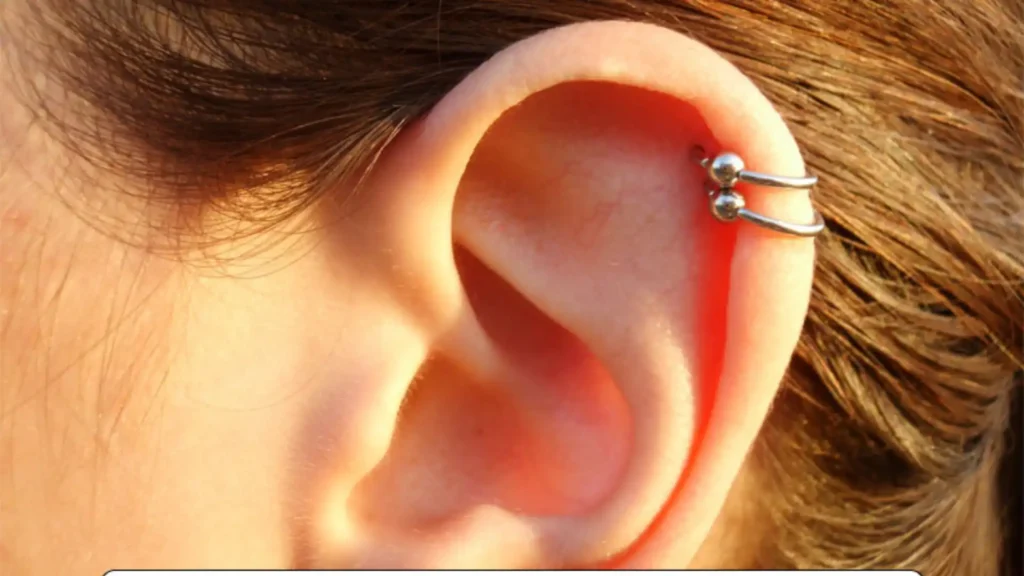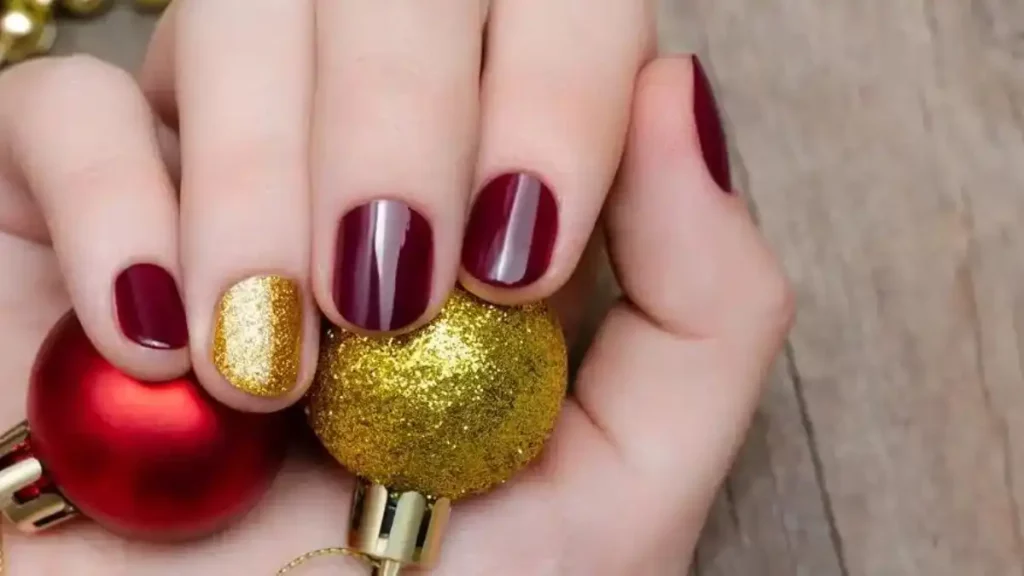Explore the world of ear modification with the double helix piercing. This trend is unique and eye-catching. It involves piercing two spots on the outer ear cartilage, creating a “double helix” look like DNA.
The double helix piercing is a stylish choice for enhancing your ear. You can choose from small studs to bold hoops. It lets you express your style in a way that’s all your own.

Start your double helix piercing journey with confidence. This guide covers everything you need to know. We’ll help you understand the ear, find the best placement, and walk you through the piercing process.
Understanding Double Helix Piercing
Ear cartilage piercing, also known as the helix anatomy, has become very popular. The double helix piercing is a special version of this trend. It gives a unique and personalized look. This piercing goes through the firm tissue on the outer rim of the ear, called the ear helix.
What is Cartilage Piercing?
Cartilage piercing means making a hole in the firm, flexible tissue of the upper ear. It’s different from earlobe piercings, which go through soft tissue. Cartilage piercings need a more careful and precise method.
Anatomy of the Ear Helix
The ear helix is the outermost curved part of the ear. It’s made of cartilage, making it perfect for creative piercings. The double helix piercing puts two holes along this outer ear structure.
Benefits of Double Piercing
The double helix piercing adds a unique look, allowing for many jewelry choices. It lets you express yourself through your style. Plus, it can make your ear look balanced and harmonious.
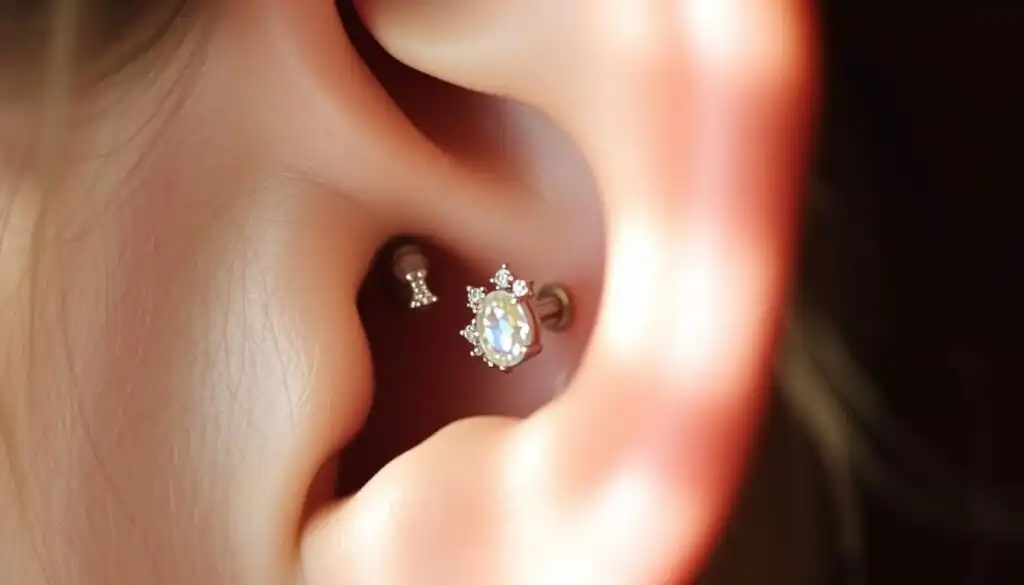
Types of Double Helix Piercings and Placement Options
Double helix piercings come in two types: the standard and the double forward helix. The standard is placed at the ear’s top, towards the back. It has a vertical look with two piercings stacked. The double forward helix is in the cartilage facing forward, just above the tragus.
Both types involve two piercings done vertically. Healing time for a helix piercing is six to nine months, sometimes longer. It takes three to six months for them to heal enough to change jewelry. They are also considered one of the least painful spots to pierce.
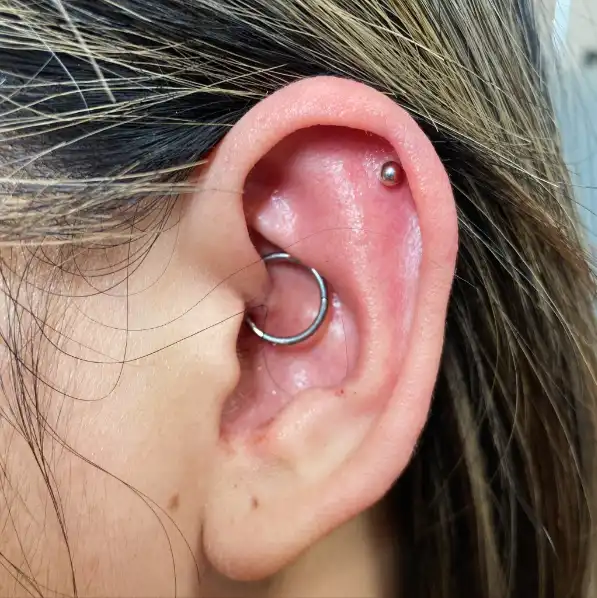
A single helix piercing can cost around $40. Prices may vary based on the piercing parlor and location. It’s best to get a helix piercing from a professional store for expertise and hygiene. Helix studs have a threaded screw backing and a flat end, unlike regular stud earrings. They come in 6.5mm and 8mm post lengths, suitable for different healing stages and comfort levels.
What to Expect During the Piercing Process
Starting your double helix piercing journey means finding a trusted piercing studio. At your first meeting, you can talk about what you want and ask questions. The piercer will clean the area and mark where the piercings will go, making sure they’re just right.
They’ll show you where the piercings will be. You can then say yes or make changes before they start.
Sterilization and Marking
The piercer will make sure everything is clean and ready. They’ll use a marker to show exactly where the piercings will be. This lets you see and adjust the spots if you need to.
The Actual Procedure
When you’re ready, the piercer will do the piercing procedure quickly and carefully. They use needles, not guns, to keep you safe. The whole thing is meant to be easy and quick.
After it’s done, the piercer will give you all the aftercare supplies you need. They’ll also tell you how to take care of your piercings to help them heal well.
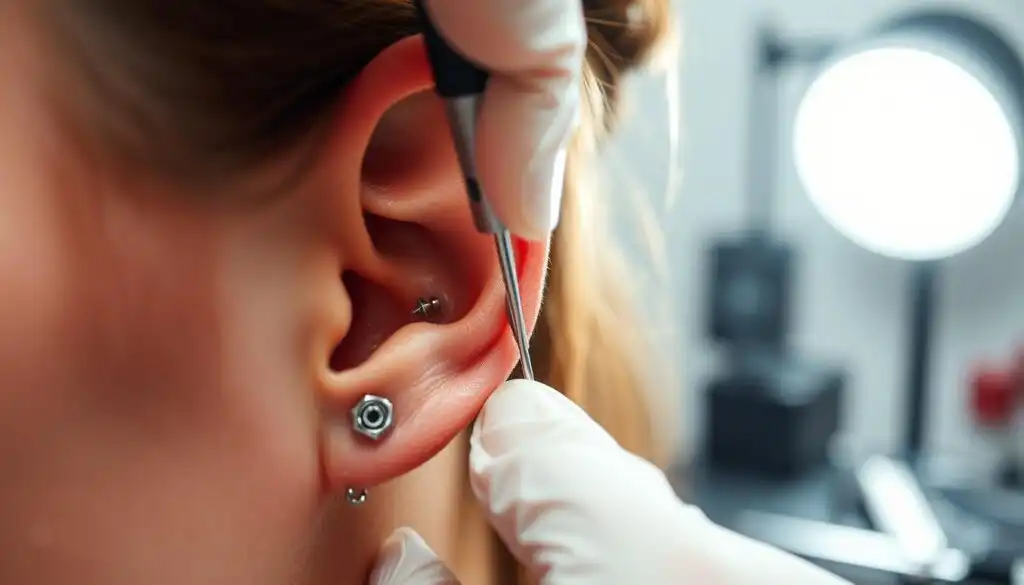
Pain Level and Discomfort Management
The pain from double helix piercings varies, but it’s usually in the medium range. It’s more painful than an earlobe piercing but less than some other piercings. People often say it feels like a sharp pinch for a brief moment.
Helix piercings, including double helix, are rated 4-5 out of 10 in pain. The pain is short and a good piercer can make it less uncomfortable. Healing takes 3-6 months, which is longer than a lobe piercing but shorter than some cartilage ones.
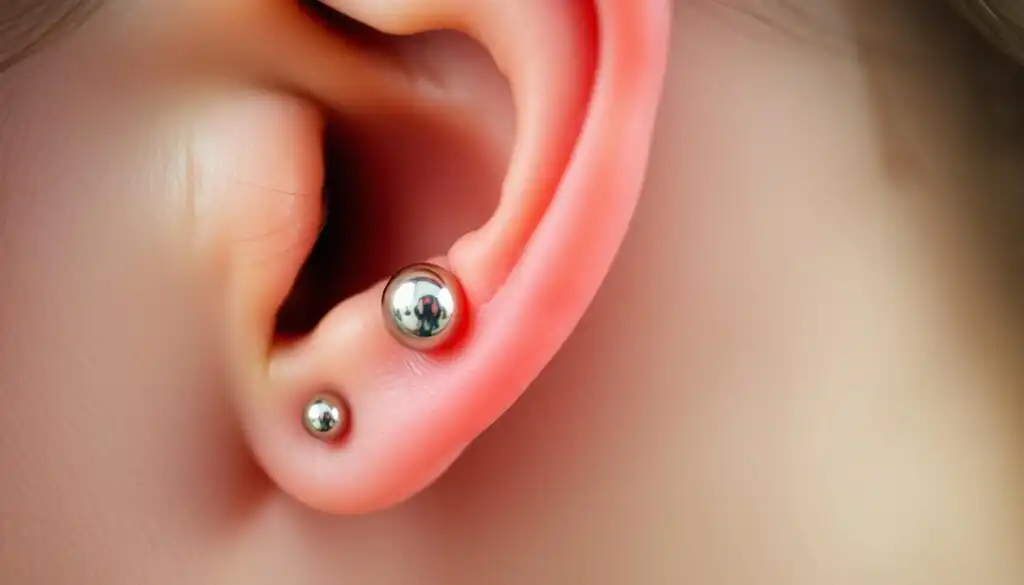
Your piercer might suggest pain meds, cold compresses, or other ways to ease discomfort. Following proper aftercare helps too. This includes saline soaks and not touching the piercing. These steps can reduce any lingering pain or discomfort as it heals.
Choosing the Right Piercing Studio
Getting a double helix piercing requires choosing a good piercing studio. It’s important to find one with skilled professional piercers. The studio’s hygiene standards and equipment quality are key.
Professional Credentials
Find a piercing studio with professional piercers who are well-trained. They should have the right certifications. This means they know about anatomy, how to sterilize, and safe piercing methods.
Hygiene Standards
High hygiene standards are crucial in a good piercing studio. Make sure they use autoclaving for their equipment. Also, check if piercers wear gloves to avoid infections.
Equipment Quality
The equipment used is very important. Piercings should be done with sterile, single-use needles. This is better than piercing guns, which can hurt more and lead to problems.
Aftercare and Healing Guidelines
Proper aftercare is key for your double helix piercing to heal well. Follow the aftercare instructions closely to avoid any issues. Start by cleaning the piercing with a saline solution, available as a spray or wipe. Stay away from harsh products like peroxide or antibacterial soaps, as they can irritate the piercing.
It’s important not to touch, twist, or play with the piercing during healing. Also, avoid sleeping on the pierced side of your head to prevent pressure or irritation. The healing time for a double helix piercing is usually 4 to 6 months with good care.
Keeping up with a regular cleaning routine is crucial for a successful piercing. By following these aftercare tips, you can have a smooth healing journey. This way, you can enjoy your new trendy ear modification.
Common Complications and How to Avoid Them
Caring for a new piercing needs patience and attention. Double helix piercings can be stylish but come with risks. It’s important to watch for signs of trouble to heal smoothly.
Signs of Infection
Infections are a big worry with piercings. Look for swelling, yellow or green discharge, and more pain. These signs mean you need to see a doctor fast. Keeping clean and following aftercare tips can help avoid infections.
Rejection and Migration
Rejection or migration happens when the body moves the jewelry. This can occur if the piercing spot is wrong or the jewelry doesn’t fit right. Watch for changes in your piercing’s position. If you see any issues, talk to your piercer.
Keloid Formation
Keloids are big, lumpy scars that can form. They’re not only ugly but can also hurt. To prevent keloids, keep your piercing clean, avoid touching it too much, and follow aftercare advice.
By watching for these problems and taking steps to prevent them, you can enjoy your double helix piercing. Stay alert and take care of your piercing to avoid complications.
Jewelry Selection and Materials
Choosing the right jewelry for your double helix piercing is key. Look for high-quality, hypoallergenic materials to avoid allergic reactions. Surgical stainless steel, titanium, and 14-karat gold are safe choices.
The jewelry you start with might be longer to fit swelling during healing. Healing usually takes 6 to 9 months. After healing, you can try different styles like studs, hoops, or curved barbells. This lets you create a unique look.
Quality is important in piercing jewelry. Brands like Junipurr Jewelry, BVLA, and Buddha Jewelry Organics are known for safety and comfort. With the right jewelry, your double helix piercing will be stylish and confident.
Cost Considerations and Investment
The cost of a double helix piercing can change based on the studio, location, and jewelry quality. It might seem like a big upfront cost. But, choosing a reputable studio and quality materials can save you money and avoid problems later.
The initial piercing cost is usually between $50 to $90. This price reflects the piercer’s skill and the studio’s cleanliness and licensing. You also need to think about jewelry prices. Basic titanium or surgical steel jewelry costs $20 to $50. Premium 14k gold or niobium pieces can cost $50 to $100.
After the piercing and jewelry, you might need to buy aftercare products. These can cost $5 to $10. If you want to change your jewelry later, expect to pay $10 to $20 for a professional change.
Discover more trends:
- Helix Piercings: Types, Procedure, Aftercare, and FAQs
- 10 Spring Nail Art Ideas Worth Experimenting With
- 10 Ear Tattoos That Look More Eye-Catching Than a Pair of Fancy Earrings
- 15 Spring almond nails this year
- Follow us on Facebook
- Follow us on Pinterest

